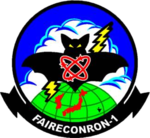VQ-1
| Fleet Air Reconnaissance Squadron 1 | |
|---|---|

VQ-1 insignia
|
|
| Active | 1 June 1955 - Present |
| Country | United States |
| Branch | |
| Type | Fleet Air Reconnaissance |
| Role |
Aerial reconnaissance signals intelligence |
| Garrison/HQ | Naval Air Station Whidbey Island |
| Nickname(s) | World Watchers |
| Engagements |
Gulf of Tonkin incident Vietnam War Gulf War Hainan Island incident Operation Enduring Freedom |
| Aircraft flown | |
| Reconnaissance |
Lockheed EP-3 WV-2Q Super Constellations EA-3 Skywarrior |
Fleet Air Reconnaissance Squadron 1 (VQ-1) is an aviation unit of the United States Navy established on 1 June 1955. Its role is aerial reconnaissance and signals intelligence. The squadron is nicknamed the "World Watchers" and is based at NAS Whidbey Island, flying Lockheed EP-3E Aries II aircraft.
The lineage of VQ-1's "World Watchers" can be traced back to two PBY-5A Catalina "Black Cats" modified for electronic reconnaissance during World War II. The unit formally established as the Special Electronic Search Project at NAS Sangley Point, in October 1951. By 13 May 1953, when it was redesignated Detachment Able of Airborne Early Warning Squadron One (VW-1), the unit operated four P4M-1Q Mercator.
When Detachment Able was reorganized into Electronic Countermeasures Squadron One (VQ-1) at Iwakuni, Japan on 1 June 1955, it was the first squadron dedicated to electronic warfare. The EA-3 Skywarrior served the squadron for the next three decades.
In 1960, not only was VQ-1 moved to Atsugi, Japan, and redesignated Fleet Air Reconnaissance Squadron ONE, but the last Mercator was retired and replaced by the first of many WV-2Q Super Constellations (also known as "Willie Victor"). They would remain the backbone of VQ-1's long-range, land-based reconnaissance efforts through the Vietnam War.
The squadron's involvement in the Vietnam War started characteristically, at the very beginning when a Skywarrior crew was awarded the Navy Unit Commendation for their role in the Gulf of Tonkin incident of 2–5 August 1964. For the next nine years, VQ-1 would operate from Da Nang, NAS Cubi Point, Bangkok, and aircraft carriers on patrol in Yankee Station and other bases in Southeast Asia. VQ-1's aircrews supported countless air strikes and are credited with assisting in the destruction of numerous Mig aircraft and Komar patrol boats.
...
Wikipedia
